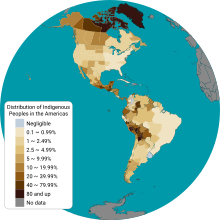Amerind (people)

|
|
| Total population | |
|---|---|
| Approximately 69 million | |
| Regions with significant populations | |
|
|
25.7 million |
|
|
14.4 million |
|
|
6.8 million |
|
|
6.0 million |
|
|
3.4 million |
|
|
3–5 million |
|
|
2.0 million |
|
|
1.4 million |
|
|
1.4 million |
|
|
955,000 |
|
|
818,000 |
|
|
524,000 |
|
|
520,000 |
|
|
444,000 |
|
|
450,000 |
|
|
95,000 |
|
|
70,000 |
|
|
114,000 |
|
|
60,000 |
|
|
51,000 |
|
|
40,000 (Maya) |
|
|
19,000 |
|
|
12,000–24,000 |
|
|
3,000 |
|
|
2,000 |
|
|
1,500 |
| Languages | |
| Indigenous languages of the Americas, English, Spanish, Portuguese, French, Danish, Dutch | |
| Religion | |
The indigenous peoples of the Americas are the pre-Columbian peoples of the Americas and their descendants.
Although some indigenous peoples of the Americas were traditionally hunter-gatherers—and many, especially in the Amazon basin, still are—many groups practiced aquaculture and agriculture. The impact of their agricultural endowment to the world is a testament to their time and work in reshaping and cultivating the flora indigenous to the Americas. Although some societies depended heavily on agriculture, others practiced a mix of farming, hunting, and gathering. In some regions the indigenous peoples created monumental architecture, large-scale organized cities, chiefdoms, states, and empires.
Many parts of the Americas are still populated by indigenous peoples; some countries have sizable populations, especially Belize, Bolivia, Chile, Ecuador, Greenland, Guatemala, Mexico, and Peru. At least a thousand different indigenous languages are spoken in the Americas. Some, such as the Quechuan languages, Aymara, Guaraní, Mayan languages, and Nahuatl, count their speakers in millions. Many also maintain aspects of indigenous cultural practices to varying degrees, including religion, social organization, and subsistence practices. Like most cultures, over time, cultures specific to many indigenous peoples have evolved to incorporate traditional aspects, but also cater to modern needs. Some indigenous peoples still live in relative isolation from Western culture and a few are still counted as uncontacted peoples.
...
Wikipedia
